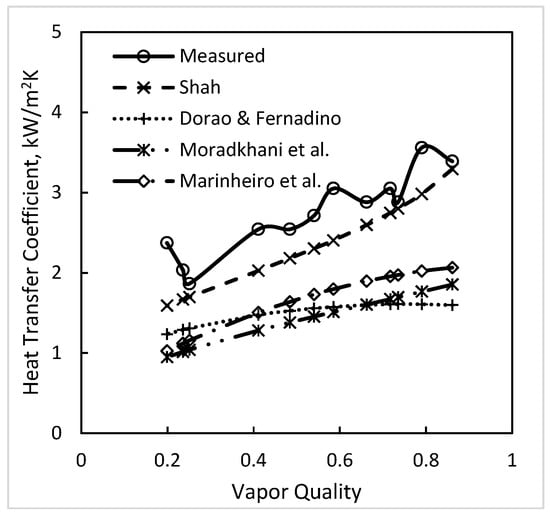Journal Description
Thermo
Thermo
is an international, peer-reviewed, open access journal on all aspects of thermal sciences, including key features on thermodynamics, statistical mechanics, kinetic theory and satellite areas, published quarterly online by MDPI.
- Open Access— free for readers, with article processing charges (APC) paid by authors or their institutions.
- High Visibility: indexed within Scopus, EBSCO, and other databases.
- Rapid Publication: manuscripts are peer-reviewed and a first decision is provided to authors approximately 23.2 days after submission; acceptance to publication is undertaken in 6.1 days (median values for papers published in this journal in the second half of 2023).
- Recognition of Reviewers: APC discount vouchers, optional signed peer review, and reviewer names published annually in the journal.
- Thermo is a companion journal of Entropy.
Latest Articles
An Evaluation of Correlations for Predicting the Heat Transfer Coefficient during the Condensation of Saturated and Superheated Vapors Inside Channels
Thermo 2024, 4(2), 164-184; https://doi.org/10.3390/thermo4020010 - 01 Apr 2024
Abstract
►
Show Figures
Condensation heat transfer is involved in many industrial applications. Therefore, it is important to know the relative accuracy of the available methods for predicting heat transfer. Condensation can occur with saturated as well as superheated vapors. Predictive methods for both conditions were evaluated
[...] Read more.
Condensation heat transfer is involved in many industrial applications. Therefore, it is important to know the relative accuracy of the available methods for predicting heat transfer. Condensation can occur with saturated as well as superheated vapors. Predictive methods for both conditions were evaluated using a wide range of data. Twelve well-known correlations for the condensation of saturated vapor, including the most recent ones, were compared with data for 51 pure fluids and mixtures from 132 sources in horizontal and vertical channels of many shapes. Channel hydraulic diameters were 0.08–49 mm, the mass flux was 1.1–1400 kg/m2s, and the reduced pressure range was 0.0006–0.949. The fluids included water, CO2, ammonia, hydrocarbons, halocarbon refrigerants, various chemicals, and heat transfer fluids. The best predictive technique was identified. The three most commonly used models for heat transfer during the condensation of superheated vapors were studied. They were first compared with test data using measured saturated condensation and forced convection heat transfer coefficients to select the best model. The selected model was then compared with test data using various correlations for heat transfer coefficients needed in the model. The best correlations to use in the model were identified. The results of this research are presented, as are recommendations for use in design.
Full article
Open AccessArticle
Molecular, Crystalline, and Microstructures of Lipids from Astrocaryum Species in Guyana and Their Thermal and Flow Behavior
by
Shaveshwar Deonarine, Navindra Soodoo, Laziz Bouzidi, R. J. Neil Emery, Sanela Martic and Suresh S. Narine
Thermo 2024, 4(1), 140-163; https://doi.org/10.3390/thermo4010009 - 12 Mar 2024
Abstract
The phase behavior of lipids extracted from Astrocaryum vulgare (AV) and Astrocaryum aculeatum (AA) pulp and kernels and their microstructural, thermal and flow properties were studied. The lipid profiles, crystal structures, microstructures, thermal stabilities and flow behaviors of these lipids provided important structure–function information
[...] Read more.
The phase behavior of lipids extracted from Astrocaryum vulgare (AV) and Astrocaryum aculeatum (AA) pulp and kernels and their microstructural, thermal and flow properties were studied. The lipid profiles, crystal structures, microstructures, thermal stabilities and flow behaviors of these lipids provided important structure–function information that are useful to assess potential applications in the food, cosmetic and pharmaceutical industries. AV and AA fruits were sourced from the lowlands and rainforests, respectively, of Guyana. AV and AA pulp oils (AVP and AAP) were distinguished from each other in composition and unsaturation, with AVP oils being predominated by a di-unsaturated TAG (2-(palmitoyloxy)propane-1,3-diyl dioleate (POO)) and AAP oils predominated by propane-1,2,3-triyl trioleate (OOO); there were unsaturation levels of 65% and 80%, respectively. The main fatty acids in AVP oils were oleic, palmitic and stearic; for AAP, these were oleic, linoleic, palmitic and stearic. The kernel fats of AV and AA were similar in composition and had saturation levels of 80%, being mainly comprised of tri-saturated TAGs propane-1,2,3-triyl tridodecanoate (LLL) and 3-(tetradecanoyloxy)propane-1,2-diyl didodecanoate (LML). The onset of mass loss
(This article belongs to the Special Issue Editorial Board Members’ Collection Series: Molecular Simulation and Thermodynamics)
►▼
Show Figures

Figure 1
Open AccessReview
A Review on Machine/Deep Learning Techniques Applied to Building Energy Simulation, Optimization and Management
by
Francesca Villano, Gerardo Maria Mauro and Alessia Pedace
Thermo 2024, 4(1), 100-139; https://doi.org/10.3390/thermo4010008 - 06 Mar 2024
Abstract
Given the climate change in recent decades and the ever-increasing energy consumption in the building sector, research is widely focused on the green revolution and ecological transition of buildings. In this regard, artificial intelligence can be a precious tool to simulate and optimize
[...] Read more.
Given the climate change in recent decades and the ever-increasing energy consumption in the building sector, research is widely focused on the green revolution and ecological transition of buildings. In this regard, artificial intelligence can be a precious tool to simulate and optimize building energy performance, as shown by a plethora of recent studies. Accordingly, this paper provides a review of more than 70 articles from recent years, i.e., mostly from 2018 to 2023, about the applications of machine/deep learning (ML/DL) in forecasting the energy performance of buildings and their simulation/control/optimization. This review was conducted using the SCOPUS database with the keywords “buildings”, “energy”, “machine learning” and “deep learning” and by selecting recent papers addressing the following applications: energy design/retrofit optimization, prediction, control/management of heating/cooling systems and of renewable source systems, and/or fault detection. Notably, this paper discusses the main differences between ML and DL techniques, showing examples of their use in building energy simulation/control/optimization. The main aim is to group the most frequent ML/DL techniques used in the field of building energy performance, highlighting the potentiality and limitations of each one, both fundamental aspects for future studies. The ML approaches considered are decision trees/random forest, naive Bayes, support vector machines, the Kriging method and artificial neural networks. The DL techniques investigated are convolutional and recursive neural networks, long short-term memory and gated recurrent units. Firstly, various ML/DL techniques are explained and divided based on their methodology. Secondly, grouping by the aforementioned applications occurs. It emerges that ML is mostly used in energy efficiency issues while DL in the management of renewable source systems.
Full article
(This article belongs to the Special Issue Innovative Technologies to Optimize Building Energy Performance)
►▼
Show Figures

Figure 1
Open AccessArticle
Significance and Optimization of Operating Parameters in Hydrothermal Carbonization Using RSM–CCD
by
Numan Luthfi, Takashi Fukushima, Xiulun Wang and Kenji Takisawa
Thermo 2024, 4(1), 82-99; https://doi.org/10.3390/thermo4010007 - 18 Feb 2024
Cited by 1
Abstract
To ascertain the significance of temperature and residence time of hydrothermal carbonization (HTC) in controlling hydrochar production, multiple regression was employed based on central composite design (CCD) to model the responses of mass yield (MY) and higher heating value (HHV). The hydrothermal reaction
[...] Read more.
To ascertain the significance of temperature and residence time of hydrothermal carbonization (HTC) in controlling hydrochar production, multiple regression was employed based on central composite design (CCD) to model the responses of mass yield (MY) and higher heating value (HHV). The hydrothermal reaction was explored at temperatures and times ranging from 150 to 250 °C and 0.5 to 3.5 h. Sorghum bagasse (SB) and microalgae (MA) were used to complex the reaction due to their differences in organic constituents. Simultaneously, the operating parameters were optimized by maximizing the response values under domain constraints in the HHV models. The results show that at least temperature and time in the linear system played a significant role in determining the solids recovery and the energy generation of hydrochars (p-values = 0.00), regardless of the biomass type. Moreover, the optimum conditions of SB and MA hydrochars can be achieved by increasing the temperature to the limit of 250 °C and prolonging the time to 3.5 and 3.25 h, respectively. Both respective conditions resulted in maximum HHVs of 27.54 and 35.83 MJ kg−1.
Full article
(This article belongs to the Special Issue Lifetime Prediction of Polymeric Materials)
►▼
Show Figures
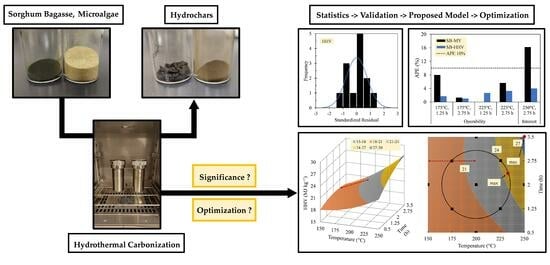
Graphical abstract
Open AccessArticle
Coupled Modeling of the Surface Pipeline Network in a Low-Enthalpy Geothermal Field
by
Stefanos Lempesis and Vassilis Gaganis
Thermo 2024, 4(1), 65-81; https://doi.org/10.3390/thermo4010006 - 15 Feb 2024
Abstract
►▼
Show Figures
This paper addresses the often overlooked, yet critical, aspect of designing and optimizing the surface pipeline network for the transportation of geothermal fluids from the wellheads to the delivery point, such as greenhouses, food drying plants, or fish farming units. While research on
[...] Read more.
This paper addresses the often overlooked, yet critical, aspect of designing and optimizing the surface pipeline network for the transportation of geothermal fluids from the wellheads to the delivery point, such as greenhouses, food drying plants, or fish farming units. While research on the geothermal industry predominately focuses on the reservoir and well engineering aspects of exploitation, insufficient attention has been given to the design of the pipeline network, leading to improper design and significant, yet avoidable, energy losses. Thus, this paper presents a comprehensive methodology for modeling and simulating geothermal fluid flow within the pipeline network by fully considering all hydraulic (friction, viscous flow, and gravity effects) and thermal (open air and underground pipeline heat loss) phenomena. These two aspects are handled simultaneously by setting up and solving the coupled set of the governing (differential) equations. We also demonstrate the difficulties that arise when attempting the solution of the mathematical problem, such as potential instability or lack of convergence. Finally, a fully detailed study of the real-world geothermal production system is presented utilizing the developed methodology to optimize the design and operation conditions of the system. By integrating debottlenecking strategies into the analysis, this approach not only maximizes power output, but also identifies and mitigates constraints within the system, ensuring efficient operation and performance increase.
Full article

Figure 1
Open AccessArticle
Effects of Preheating on Thermal Behavior in Inconel 718 Processed by Additive Manufacturing
by
Hasina Tabassum Chowdhury, Thaviti Naidu Palleda, Naoto Kakuta and Koji Kakehi
Thermo 2024, 4(1), 48-64; https://doi.org/10.3390/thermo4010005 - 14 Feb 2024
Abstract
►▼
Show Figures
Preheating is important to improve the mechanical properties of nickel-based superalloys processed by additive manufacturing. The microstructure of IN718 was found to be influenced by the preheating temperature. Different preheating temperatures affect mechanical properties by changing microstructures. This work aims to clarify the
[...] Read more.
Preheating is important to improve the mechanical properties of nickel-based superalloys processed by additive manufacturing. The microstructure of IN718 was found to be influenced by the preheating temperature. Different preheating temperatures affect mechanical properties by changing microstructures. This work aims to clarify the thermal behavior for two preheated base plate temperatures (200 °C and 600 °C) on the IN718 superalloy built by the selective laser melting (SLM) process using the finite element method and experiments. The simulation findings indicate that the preheated 600 °C model has a deeper melt pool, a slower transformation of liquid to solid, and a slower cooling rate compared to the 200 °C model. As a result, the interdendritic Niobium (Nb) segregation of IN718 is reduced, thus improving the mechanical properties of additive-manufactured IN718 using the laser. The solidification map derived from the simulation indicates a columnar microstructure for the IN718 superalloy. Preheating increased the size of the dendrite structure and reduced elemental segregation, but it did not affect the morphology or size of crystal grains. We focused on comparing the temperature gradient and cooling rate for the two preheated base plate temperatures using the solidification map of IN718. The simulation confirmed that preheating does not affect the grain structure.
Full article

Figure 1
Open AccessReview
Theoretical Characterization of Thermal Conductivities for Polymers—A Review
by
Cornelia Breitkopf
Thermo 2024, 4(1), 31-47; https://doi.org/10.3390/thermo4010004 - 13 Feb 2024
Abstract
Polymer thermal conductivities play an important role for their potential use in industrial applications. Therefore, great efforts have been made to investigate fundamental structure–property relationships to understand and predict thermal conductivities for polymers and their composites. The review summarizes selected well-proven microscopic theoretical
[...] Read more.
Polymer thermal conductivities play an important role for their potential use in industrial applications. Therefore, great efforts have been made to investigate fundamental structure–property relationships to understand and predict thermal conductivities for polymers and their composites. The review summarizes selected well-proven microscopic theoretical approaches to calculate thermal conductivities such as EMD, NEMD, EMT, and BTE, and cites examples to focus on different qualitative aspects of recent polymer theoretical research. Examples other than polymer materials are given as supplemental information to support the general discussion of heat transport phenomena in solid materials.
Full article
(This article belongs to the Special Issue Thermal Processes and Thermal Properties of Sustainable Polymeric Materials)
►▼
Show Figures

Figure 1
Open AccessEditorial
2023: A Transitional Phase for Thermo?
by
Johan Jacquemin
Thermo 2024, 4(1), 29-30; https://doi.org/10.3390/thermo4010003 - 26 Jan 2024
Abstract
Prior starting this editorial, I do want to wish all of you a Happy New Year and a great 2024 [...]
Full article
Open AccessArticle
An Experimental Investigation on the Pool Boiling Heat Transfer of R-134a on Microporous Cu-MWCNT Composite Surfaces
by
Ajay D. Pingale, Anil S. Katarkar, Mahadev Madgule, Swapan Bhaumik and Sachin U. Belgamwar
Thermo 2024, 4(1), 16-28; https://doi.org/10.3390/thermo4010002 - 17 Jan 2024
Abstract
►▼
Show Figures
Multiwalled carbon nanotubes (MWCNTs) exhibit outstanding physical properties, including high thermal conductivity, excellent mechanical strength, and low electrical resistivity, which make them suitable candidates for a variety of applications. The work presented in this paper focuses on the pool boiling performance of refrigerant
[...] Read more.
Multiwalled carbon nanotubes (MWCNTs) exhibit outstanding physical properties, including high thermal conductivity, excellent mechanical strength, and low electrical resistivity, which make them suitable candidates for a variety of applications. The work presented in this paper focuses on the pool boiling performance of refrigerant R-134a on microporous Cu-MWCNT composite surface layers. A two-stage electrodeposition technique was used to fabricate Cu-MWCNT composite coatings. In order to achieve variation in the surface properties of the Cu-MWCNT composite surface layer, electrodeposition was carried out at various bath temperatures (25 °C, 30 °C, 35 °C, and 40 °C). All surfaces coated with the Cu-MWCNT composite demonstrated superior boiling performance compared to the uncoated surface. Heat transfer coefficient (HTC) values for Cu-MWCNT composite surface layers, prepared at bath temperatures of 25 °C, 30 °C, 35 °C, and 40 °C, exhibited improvements of up to 1.75, 1.88, 2.06, and 2.22, respectively, in comparison to the plain Cu surface.
Full article
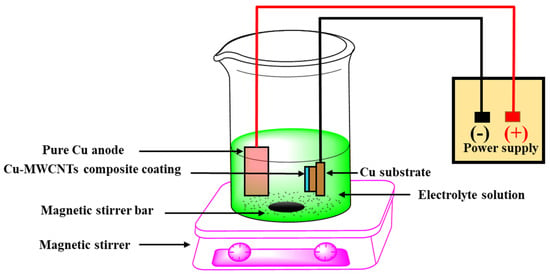
Figure 1
Open AccessArticle
Analysis of Supersonic Flows inside a Steam Ejector with Liquid–Vapor Phase Change Using CFD Simulations
by
Hugues Charton, Christian Perret and Hai Trieu Phan
Thermo 2024, 4(1), 1-15; https://doi.org/10.3390/thermo4010001 - 12 Jan 2024
Abstract
In this work, different CFD models to compute flows inside a steam ejector were investigated. The results were compared to the analytical models as well as the experimental results from the literature. All the simulations gave realistic results from the hydrodynamic perspective with
[...] Read more.
In this work, different CFD models to compute flows inside a steam ejector were investigated. The results were compared to the analytical models as well as the experimental results from the literature. All the simulations gave realistic results from the hydrodynamic perspective with a relative error of the entrainment ratio between 25% and 40% compared to reference experimental data. However, an analysis of the temperature profiles showed that only realistic results from the thermodynamic perspective were given by multiphase calculations. The first multiphase model tested was the so-called Wet-Steam model from ANSYS Fluent. This model gave inconsistent results for the steam ejector CFD simulation due to the physical boundaries of this model. The second model tested was the Eulerian mixture model, which gave the most realistic results in terms of the physical conditions of the liquid and vapor phases inside the ejector. It also showed that the phase change could have a significant impact on the value of the critical output pressure as a way to improve the performance of the ejector.
Full article
(This article belongs to the Special Issue Numerical Simulations for Thermal Engineering and Thermodynamic Systems)
►▼
Show Figures
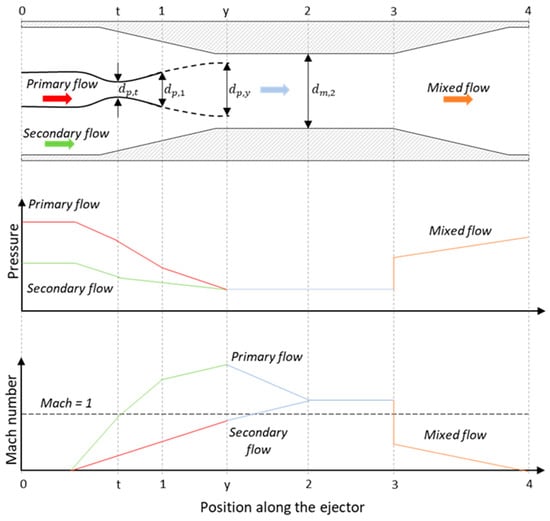
Figure 1
Open AccessArticle
Skin-Friction and Forced Convection from Rough and Smooth Plates
by
Aubrey Jaffer
Thermo 2023, 3(4), 711-775; https://doi.org/10.3390/thermo3040040 - 16 Dec 2023
Abstract
►▼
Show Figures
Since the 1930s, theories of skin-friction drag from plates with rough surfaces have been based by analogy to turbulent flow in pipes with rough interiors. Failure of this analogy at small fluid velocities has frustrated attempts to create a comprehensive theory. Utilizing the
[...] Read more.
Since the 1930s, theories of skin-friction drag from plates with rough surfaces have been based by analogy to turbulent flow in pipes with rough interiors. Failure of this analogy at small fluid velocities has frustrated attempts to create a comprehensive theory. Utilizing the concept of a self-similar roughness that disrupts the boundary layer at all scales, this investigation derives formulas for a rough or smooth plate’s skin-friction coefficient and forced convection heat transfer given its characteristic length, root-mean-squared (RMS) height-of-roughness, isotropic spatial period, Reynolds number, and the fluid’s Prandtl number. This novel theory was tested with 456 heat transfer and friction measurements in 32 data-sets from one book, six peer-reviewed studies, and the present apparatus. Compared with the present theory, the RMS relative error (RMSRE) values of the 32 data-sets span 0.75% through 8.2%, with only four data-sets exceeding 6%. Prior work formulas have smaller RMSRE on only four of the data-sets.
Full article

Graphical abstract
Open AccessFeature PaperReview
Industrial Technologies for CO2 Reduction Applicable to Glass Furnaces
by
Dario Atzori, Simone Tiozzo, Michela Vellini, Marco Gambini and Stefano Mazzoni
Thermo 2023, 3(4), 682-710; https://doi.org/10.3390/thermo3040039 - 07 Dec 2023
Abstract
In recent years, the European Union’s legislation about sustainable development has promoted the gradual decarbonization of all industrial sectors, pushing towards the final goal of a carbon-neutral European glass industry in 2050. Moreover, the COVID-19 pandemic, the war in Ukraine and the consequent
[...] Read more.
In recent years, the European Union’s legislation about sustainable development has promoted the gradual decarbonization of all industrial sectors, pushing towards the final goal of a carbon-neutral European glass industry in 2050. Moreover, the COVID-19 pandemic, the war in Ukraine and the consequent natural gas supply crisis have led to significant increases in the costs of traditional energy commodities and CO2 emission allowances. In this scenario, the European glass industry, which is both an energy-intensive sector and a large emitter of CO2, needs to reduce its specific energy consumption, change its energy sources and decarbonize its production process. In order to understand and support this metamorphosis of the glass industry, the follwing questions must be answered: are the technologies reported in scientific publications merely theoretical exercises, or can they be adopted by the industry? In what timeframe can they be adopted? The aim of this study is to review consolidated and emerging technologies applicable to the glass industry and investigate which ones can be implemented in the short or medium term to reduce energy consumption and CO2 emissions related to the glass production process. This study is based on a review of the literature, the materials presented in technical conferences and the opinions of interviewed experts. This study showed that the literature is not very substantial, lacking detailed information on technologies and their effects in terms of energy savings or emissions. More information can be found in the proceedings of selected specialist conferences. This study found that, on one hand, some technologies are mature and only adopted when economically viable, and appropriate boundary conditions are available; the state of the art regarding these technologies was already extensively covered in past publications (e.g., cullet pre-heating). On the other hand, there are many promising technologies in the research or testing phase (i.e., steam methane reforming, process electrification, use of hydrogen); in-depth studies about them are limited due to the novelty of the solutions that they propose or not available due to industrial secrecy issues. In addition to periodicals and specialized conferences, interviews were carried out with managers and technicians from industry, as well as technicians from the Italian glass research institute and industrial machinery producers (especially melting furnaces). The interviews represent added value of this publication, useful in helping us to truly understand the state of the art and degree of readiness of the technologies identified. In addition, the production values of the glass industry were studied: our research confirmed that the most important sub-sectors are flat and container glass, as well as the largest glass-producing nations/continents. Finally, a review of specific energy consumption and CO2 emissions indexes was carried out.
Full article
(This article belongs to the Special Issue Feature Papers of Thermo in 2023)
►▼
Show Figures
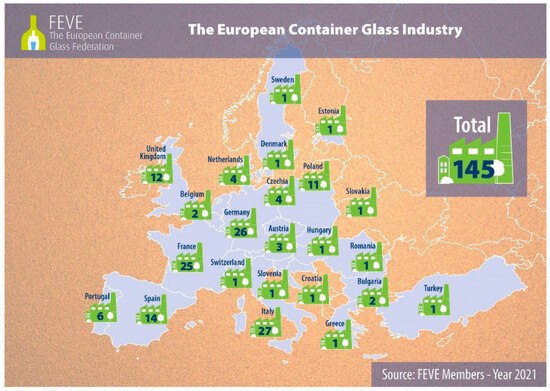
Figure 1
Open AccessArticle
Simplified Modeling and Experimental Validation of a Combi-Storage Distribution Tank for Seasonal Thermal Energy Storage Systems
by
Tryfon C. Roumpedakis, Aris-Dimitrios Leontaritis, Prokopios Vlachogiannis, Efstratios Varvagiannis, Antonios Charalampidis and Sotirios Karellas
Thermo 2023, 3(4), 657-681; https://doi.org/10.3390/thermo3040038 - 29 Nov 2023
Abstract
This study regards the evaluation of the performance of a thermally stratified tank as an intermediate combi-storage tank for a solar-driven residential thermal system coupled to a seasonal energy storage system. In such applications, the efficient operation of this intermediate tank is crucial
[...] Read more.
This study regards the evaluation of the performance of a thermally stratified tank as an intermediate combi-storage tank for a solar-driven residential thermal system coupled to a seasonal energy storage system. In such applications, the efficient operation of this intermediate tank is crucial to the enhanced exploitation of the harvested solar energy and the minimization of heat losses. In this perspective, the development of a dedicated model in TRNSYS software and its validation with experimental results are investigated. With respect to the simulation model’s discretization, it was found that beyond 60 nodes, the benefits to the model’s accuracy are almost negligible. Comparing the experimental data with the simulation’s results, the predicted temperature profile converges accurately to the measured values under steady-state conditions (threshold stabilization period of 1000 s after charging/discharging has occurred). However, the response of the model deviates considerably under transient conditions due to the lack of detailed inertia modeling of both the tank and the rest of the system components. Conclusively, the developed 1D simulation model is adequate for on- and off-design models where transient phenomena are of reduced importance, whereas for dynamic and semi-dynamic simulations, more detailed models are needed.
Full article
(This article belongs to the Special Issue Hybrid Energy Recovery, Storage and Utilization in Buildings and Industrial Applications)
►▼
Show Figures
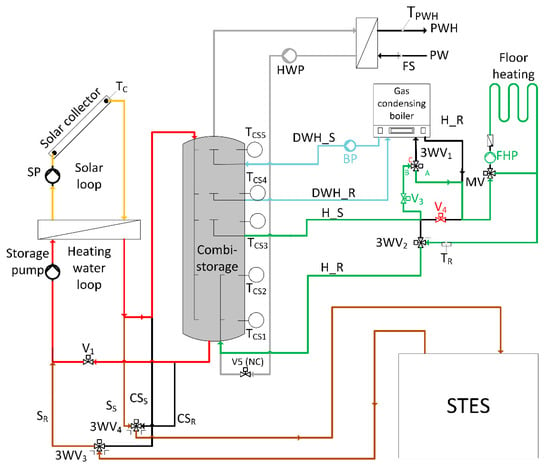
Figure 1
Open AccessArticle
Thermo-Mechanical and Mechano-Thermal Effects in Liquids Explained by Means of the Dual Model of Liquids
by
Fabio Peluso
Thermo 2023, 3(4), 625-656; https://doi.org/10.3390/thermo3040037 - 09 Nov 2023
Abstract
►▼
Show Figures
We pursue to illustrate the capabilities of the Dual Model of Liquids (DML) showing that it may explain crossed effects notable in Non-Equilibrium Thermodynamics (NET). The aim of the paper is to demonstrate that the DML may correctly model the thermodiffusion, in particular
[...] Read more.
We pursue to illustrate the capabilities of the Dual Model of Liquids (DML) showing that it may explain crossed effects notable in Non-Equilibrium Thermodynamics (NET). The aim of the paper is to demonstrate that the DML may correctly model the thermodiffusion, in particular getting formal expressions for positive and negative Soret coefficient, and another “unexpected” mechano-thermal effect recently discovered in liquids submitted to shear strain, for which the first-ever theoretical interpretation is provided. Both applications of the DML are supported by the comparison with experimental data. The phenomenology of liquids, either pure or mixtures, submitted to external force fields is characterized by coupled effects, for instance mechano-thermal and thermo-mechanical effects, depending on whether the application of a mechanical force field generates a coupled thermal effect in the liquid sample or vice-versa. Although these phenomena have been studied since their discoveries, dating back to the XIX century, no firm theoretical interpretation exists yet. Very recently the mesoscopic model of liquids DML has been proposed and its validity and applicability demonstrated in several cases. According to DML, liquids are arranged on a mesoscopic scale by means of aggregates of molecules, or liquid particles. These structures share the liquid world with a population of lattice particles, i.e., elastic waves that interact with the liquid particles by means of an inertial force, allowing the mutual exchange of energy and momentum between the two populations. The hit particle relaxes the acquired energy and momentum due to the interaction, giving them back to the system a step forward and a time-lapse later, alike in a tunnel effect.
Full article

Figure 1
Open AccessArticle
Insights about Modelling Environmental Spatiotemporal Actions in Thermal Analysis of Concrete Dams: A Case Study
by
Noemi Schclar Leitão and Sérgio Oliveira
Thermo 2023, 3(4), 605-624; https://doi.org/10.3390/thermo3040036 - 23 Oct 2023
Abstract
►▼
Show Figures
In order to conduct thermal analysis of concrete dams, it is necessary to assess and validate the spatiotemporal representations used for modeling the solar radiation and the water temperature boundary conditions. To illustrate this procedure, the thermal analysis of a concrete multiple-arch dam
[...] Read more.
In order to conduct thermal analysis of concrete dams, it is necessary to assess and validate the spatiotemporal representations used for modeling the solar radiation and the water temperature boundary conditions. To illustrate this procedure, the thermal analysis of a concrete multiple-arch dam is presented. The article starts by providing an overview of the problem before focusing explicitly on the estimation of solar radiation distribution. Within this section, a comparison between the solar irradiance computed on the downstream face of the dam with or without considering the beam radiation shading at different times of the year is presented. This is followed by an analysis of the seasonal behavior of the water temperature of the dam’s reservoir based on measured data. After calibrating an empirical/statistical law based on temperatures measured at different depths, it is compared with the values estimated by a hydrodynamic model and some temperature profiles measured upstream of the dam. Finally, the article compares the results obtained with the thermal analysis versus the temperature measured by thermometers installed in the concrete.
Full article
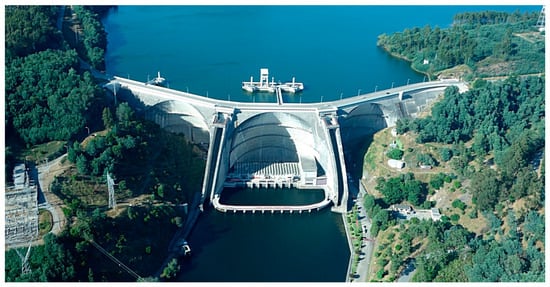
Figure 1
Open AccessArticle
Alterations of a CaCl2 Alginate Composite for Thermochemical Heat Storage during the Hydration in a 1 L Packed Bed Laboratory Reactor
by
Stephan Heitmann, Tamás Simon, Andrea Osburg and Michael Fröba
Thermo 2023, 3(4), 593-604; https://doi.org/10.3390/thermo3040035 - 10 Oct 2023
Cited by 1
Abstract
A composite material of alginate and CaCl2 was tested in a laboratory reactor (1 L) for its ability to thermochemically store heat. The material was exposed to air at 25 °C and 25% RH to prevent the salt from dissolving, and the
[...] Read more.
A composite material of alginate and CaCl2 was tested in a laboratory reactor (1 L) for its ability to thermochemically store heat. The material was exposed to air at 25 °C and 25% RH to prevent the salt from dissolving, and the heat evolution was observed over a period of 15 cycles. To evaluate the changes in the material, samples were taken after 5, 10 and 15 cycles and the material properties and calorimetric characteristics were examined. A change of the material in favor of the heat release was determined, so that an increase of the heat storage capacity from 1.28 kJ∙cm−3 to 2.11 kJ∙cm−3 was detected, with a simultaneous steep decrease of the pore volume in the range from 0.01 to 10 μm. The temperature lift of the reactor showed a significant increase, with the first cycle showing the smallest amount.
Full article
(This article belongs to the Special Issue Thermal Processes and Thermal Properties of Sustainable Polymeric Materials)
►▼
Show Figures
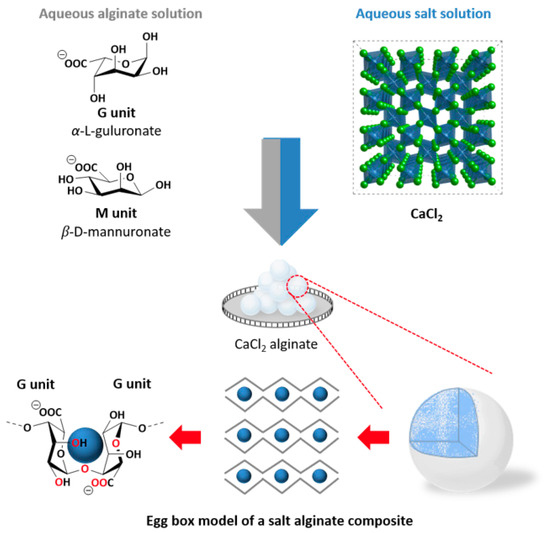
Figure 1
Open AccessArticle
On the Effective Thermophysical Properties of Phase Change Materials Embedded in Metallic Lattice Structures with Generic Topological Parameters
by
Stefano Piacquadio, Johannes Soika, Maximilian Schirp, Kai-Uwe Schröder and Sauro Filippeschi
Thermo 2023, 3(4), 566-592; https://doi.org/10.3390/thermo3040034 - 07 Oct 2023
Abstract
The recent literature has introduced the use of architected materials with a metallic lattice structure-based topology to enhance the thermal conductivity of phase change materials (PCM). The potential of such structures lies in the freedom of design with complex geometries. This, however, has
[...] Read more.
The recent literature has introduced the use of architected materials with a metallic lattice structure-based topology to enhance the thermal conductivity of phase change materials (PCM). The potential of such structures lies in the freedom of design with complex geometries. This, however, has introduced novel challenges regarding the analytical description of these materials’ effective thermophysical properties, which are used in order to treat the composite as a homogenized material. Only a few limited works have been presented thus far that have holistically addressed the calculation of such properties. The wide variety of possible geometric parameters in these materials can only be appropriately treated via an adaptable approach that can be extended to upcoming lattice geometries. With this aim in mind, the present work introduces a method to calculate the effective thermal conductivity of the discussed composite PCM. A cell-based approach to calculate the effective thermal conductivity is introduced. The method makes use of Steinmetz’s solids as a basis from which one can derive the porosity of unit cells with variable geometric parameters. Empirical factors are introduced to account for limitations due to the complex geometry and eventual manufacturing imperfections of these structures. Thus, semi-analytical formulae to describe the effective thermal conductivity of the lattice cells are derived for a variety of cuboid and hexagonal prismatic unit cells with generic topological parameters. The formulae are validated against the models and experimental results present in the literature. Finally, an analysis and discussion of the limited validity of homogenization techniques for lattice structures is presented.
Full article
(This article belongs to the Special Issue Porous Media to Improve the Thermal Performance of Phase Change Materials)
►▼
Show Figures
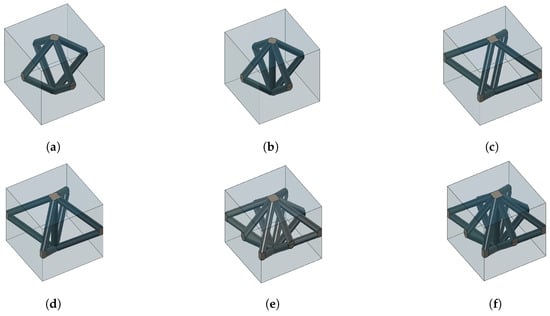
Figure 1
Open AccessFeature PaperArticle
Enthalpy of Formation of the Nitrogen-Rich Salt Guanidinium 5,5′-Azotetrazolate (GZT) and a Simple Approach for Estimating the Enthalpy of Formation of Energetic C, H, N, O Salts
by
Ana L. R. Silva, Gastón P. León, Maria D. M. C. Ribeiro da Silva, Thomas M. Klapötke and Jelena Reinhardt
Thermo 2023, 3(4), 549-565; https://doi.org/10.3390/thermo3040033 - 05 Oct 2023
Cited by 1
Abstract
The discrepancy between the calculated (CBS-4M/Jenkins) and experimentally determined enthalpies of formation recently reported for the 2:1 salt TKX-50 raised the important question of whether the enthalpies of formation of other 2:1 C, H, N, O salts calculated using the CBS-4M/Jenkins method are
[...] Read more.
The discrepancy between the calculated (CBS-4M/Jenkins) and experimentally determined enthalpies of formation recently reported for the 2:1 salt TKX-50 raised the important question of whether the enthalpies of formation of other 2:1 C, H, N, O salts calculated using the CBS-4M/Jenkins method are reliable values. The standard (p° = 0.1 MPa) enthalpy of formation of crystalline guanidinium 5,5′-azotetrazolate (GZT) (453.6 ± 3.2 kJ/mol) was determined experimentally using static-bomb combustion calorimetry and was found to be in good agreement with the literature’s values. However, using the CBS-4M/Jenkins method, the calculated enthalpy of formation of GZT was again in poor agreement with the experimentally determined value. The method we used recently to calculate the enthalpy of formation of TKX-50, based on the calculation of the heat of formation of the salt and of the corresponding neutral adduct, was then applied to GZT and provided excellent agreement with the experimentally determined value. Finally, in order to validate the findings, this method was also applied to predict the enthalpy of formation of a range of 1:1 and 2:1 salts (M+X− and (M+)2X2− salts, respectively), and the values obtained were comparable to experimentally determined values. The agreement using this approach was generally very good for both 1:1 and 2:1 salts; therefore, this approach provides a simple and reliable method which can be applied to calculate the enthalpy of formation of energetic C, H, N, O salts with much greater accuracy than the current, commonly used method.
Full article
(This article belongs to the Special Issue Feature Papers of Thermo in 2023)
►▼
Show Figures

Figure 1
Open AccessArticle
Heat–Cool: A Simpler Differential Scanning Calorimetry Approach for Measuring the Specific Heat Capacity of Liquid Materials
by
Brandon C. Wada, Oliver W. M. Baldwin and Gerald R. Van Hecke
Thermo 2023, 3(4), 537-548; https://doi.org/10.3390/thermo3040032 - 27 Sep 2023
Cited by 1
Abstract
Specific heat capacity at constant pressure cp (J K−1 g−1) is an important thermodynamic property that helps material scientists better understand molecular structure and physical properties. Engineers control temperature (through heat transfer) in physical systems. Differential Scanning Calorimetry (DSC)
[...] Read more.
Specific heat capacity at constant pressure cp (J K−1 g−1) is an important thermodynamic property that helps material scientists better understand molecular structure and physical properties. Engineers control temperature (through heat transfer) in physical systems. Differential Scanning Calorimetry (DSC) is an analytical technique that has been used for over fifty years to measure heat capacities with milligram size samples. For existing procedures, such as ASTM E1269−11 (2018), the accuracy of molar heat capacity measurements is typically ±2–5% relative to the literature values, even after calibration for both heat flow and heat capacity. A comparison of different DSC technologies is beyond the scope of this paper, but the causes of these deviations are common to all DSC instruments, although the magnitude of the deviation (observed and accepted) varies with instrument design. This paper presents a new approach (Heat–Cool) for measuring more accurate and reproducible specific heat capacities of materials. In addition to better performance, the proposed method is faster and typically requires no additional calibration beyond the routine calibration of temperature and heat flow, with melting point standards common to all applications of DSC. Accuracy, as used throughout this paper, means deviation from the literature. The estimated standard deviation of repeated measurements of the cp values obtained with the Heat–Cool technique typically falls in the ±1–2% range.
Full article
(This article belongs to the Special Issue Feature Papers of Thermo in 2023)
►▼
Show Figures
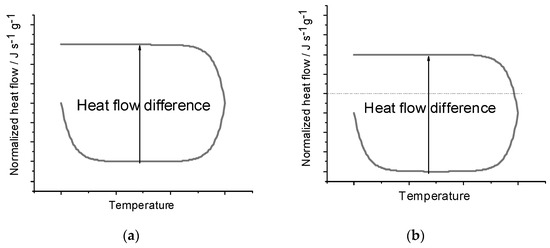
Figure 1
Open AccessArticle
A Quasi-Dimensional Model of Heat Transfer between Multi-Concentric Monolith Structures
by
Seamus P. Kane and William F. Northrop
Thermo 2023, 3(4), 515-536; https://doi.org/10.3390/thermo3040031 - 26 Sep 2023
Abstract
►▼
Show Figures
Metallic monolith structures are often used in compact reactor applications due to their superior heat transfer properties and lower pressure drop when compared to ceramic monoliths. Endothermic reactions like steam reforming depend heavily on externally supplied heat, making highly conductive supports especially useful.
[...] Read more.
Metallic monolith structures are often used in compact reactor applications due to their superior heat transfer properties and lower pressure drop when compared to ceramic monoliths. Endothermic reactions like steam reforming depend heavily on externally supplied heat, making highly conductive supports especially useful. Simulations are invaluable for designing effective reactors with complex catalyst support structures but are conventionally resource-intensive. Additionally, few dedicated heat transfer experiments between monoliths exist in prior literature. To expand general knowledge of heat transfer between metal monolith structures, this work investigated heat exchange in concentric monoliths brazed to a common mantle. A computationally inexpensive quasi-dimensional model was developed and used to predict the heat exchange effectiveness and intrinsic heat transfer rate. The model used a discretized control volume approach and simplified geometries to reduce computational intensity. The model was calibrated against experimental data collected using a steady-state flow bench. After calibration, a parametric study was performed where monolith construction and flow conditions were varied. A parametric analysis showed that for identical catalyst space velocities and volumes, heat exchange effectiveness can be increased by 43.2% and heat transfer rates by 44.8% simply through increasing the surface area to volume ratio of the monolith. The described approach serves as an alternative framework for modeling catalytic heat exchangers without heavy computation and for quickly matching monolith geometries to their intended use and operating range.
Full article

Figure 1
Highly Accessed Articles
Latest Books
E-Mail Alert
News
Topics
Topic in
Energies, Entropy, Photonics, Technologies, Thermo
Advances in Solar Technologies
Topic Editors: Jayanta Deb Mondol, Annamaria Buonomano, Biplab DasDeadline: 30 November 2024

Conferences
Special Issues
Special Issue in
Thermo
Advances in PCMs as Thermal Energy Storage in Energy Systems
Guest Editors: Behzad Rismanchi, Seyedmostafa MousaviDeadline: 25 April 2024
Special Issue in
Thermo
Annual Thermodynamics Education Issue: Methods & Results
Guest Editors: Steve Lustig, Johan JacqueminDeadline: 30 June 2024
Special Issue in
Thermo
Thermal Processes and Thermal Properties of Sustainable Polymeric Materials
Guest Editors: George Z. Papageorgiou, Johan JacqueminDeadline: 10 September 2024
Special Issue in
Thermo
Numerical Simulations for Thermal Engineering and Thermodynamic Systems
Guest Editors: Emmanouil Rogdakis, George-Rafael DomenikosDeadline: 15 September 2024


